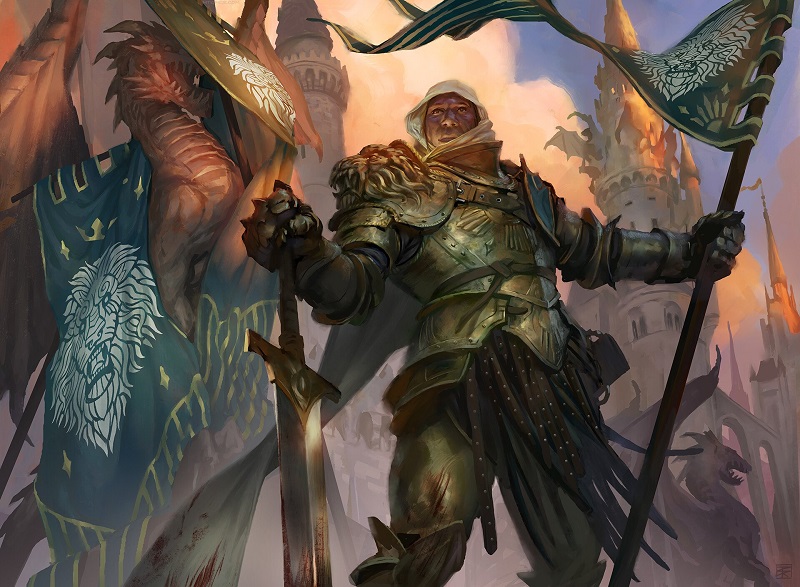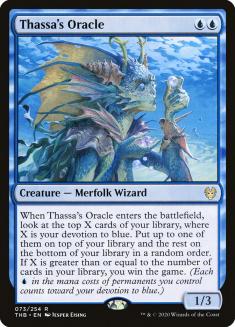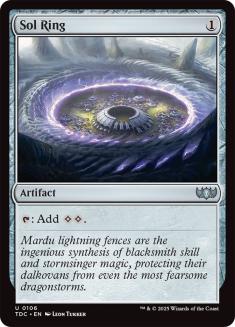Casual is a word that gets bandied about quite a bit in the context of Commander. It has meaning in its own right; it’s often used as the antithesis of competitive (which we’ll get more deeply into in a bit). It’s a mindset to both building decks and play of the game. It certainly means a broad range of different things to a great number of people. With the release of Unfinity previews this past week, it got used again, this time in the context of formats — which didn’t include Commander.
What I’ll do this time is delve into some of the meanings of the term and start to hone in on a space that we all might be able to commonly work from. I’m not going to try to create a single, unified meaning, but offer up some language and structure so that we can better understand one another (or perhaps misunderstand less). I don’t want to try to tell you exactly what casual is, just give us a way to talk about it wherever we are on the Commander spectrum.
Casual or Social?
Before we head down this road, I want assert that if we’re only going to use one adjective, I think it’s better to call Commander a social format. One of the reasons we’re going to have the following discussion is that there are so many interpretations of what casual means, we get lost before we ever get started. More importantly, while Commander certainly had its roots on the casual side when it meant only “non-tournament,” the format has always been about the gathering.
Sure, there’s a rule set, structure, and banned list like other formats, but the idea of being primarily about getting people together (secondarily playing a game) is hard-coded in Commander’s DNA — and we intend to keep it that way. The genesis of Commander’s existence is sitting around with friends and colleagues, playing a game that we all love, and not having to pay too much attention to the game state (after having spent all day paying super-close attention to game states). In focusing on our target demographic, we haven’t lost that ideal, even if a majority of the players aren’t winding down from other kind of Magic, just playing Commander.
What often confuses the issue when players use the term casual is that they may mean it on any of three different axes, which I’ll call environment, deckbuilding, and gameplay. Folks might defend a decidedly not-casual build by mentioning that they’re playing it in a beer-and-pretzels environment, asserting then that they are indeed playing casual Commander. You may have also heard me say things like “build casually, play competitively,” which shows that the streams can cross.
What Casual Is Not
Importantly, casual is not to be confused with anti-competitive. Casual Commander doesn’t seek to get rid of competition or actively work against it, so it’s not an antithesis. Even if we on the Commander Rules Committee (RC) actively mention that we don’t seek competitive balance in Commander, we’re also not doing anything to put competitive games out of business. We simply think that Commander makes a better casual format and aren’t trying to shape it into a competitive one. There are plenty of those and we’re doing something different.
I’ll use the term that Commander Advisory Group (CAG) member and noted giant thinker Jim LaPage brought up a while back when he and I were talking about it: casual Commander is acompetitive — that is, the absence of classic competition structure and attitude. We’ll still use competitive as the opposite end from casual, recognizing that they don’t exist separately, but along the same continuum. For the purposes of this piece, I’d like to use competitive as the opposite (but not opposing) side from casual on that spectrum without the implication of competitive meaning “inside a tournament.” In fact, because we’re talking about Commander in a casual context, tournaments won’t exist as part of the discussion.
Additionally important is not equating casual with bad. That could have been the case when there was the strict play dichotomy, but even then I think that was more the case in people’s minds instead of the ground truth. We also don’t want to equate casual with weak, because these days there’s a broad deckbuilding spectrum to casual play.
What Casual Is
Casual, then, is a mindset of relaxed edges within our individual elements. There might be a line over which things are obviously not casual, but the other side of that line is a sliding scale — which is part of the issue leading to mismatched expectations and why we want to have more productive conversations about it.
For me, there are two major elements to casualness. One is letting everyone into the game; the other is being very loose about the game’s edges. Our common RC opinion is that the best games of Commander are when everyone does stuff, some epic things happen, and then someone wins. I encourage you to check out the Philosophy Document for more on that topic.
Casual cares less about who does the things and who wins, prioritizing being part of the experience. We can (somewhat loosely) say that casual cares more about playing; competitive cares more about winning (and attaching no moral or ethical value to either side of the coin). If we can agree that’s the general case, we can move on to our elements.
Elements of Casual: Environment
Environment is where you’re playing the game, from your friend’s basement to the LGS to the tables behind the judge stage to, obviously, a tournament. The pressures or lack thereof in each of these settings is where it exists on the casual/competitive scale. They each have their own general feels but can also run the gamut. Even if it’s laid-back, for the purposes of our argument, a tournament is never casual, since the meta-goal is winning. Your friend’s basement is what we’d most often call the most casual, but it could also be the most competitive environment you play in. So when we say “your friend’s basement,” we’re talking generically, not about any particular person’s game room.
Environment is also impacted by the people with whom you’re playing. Your regular group is significantly different from sitting with three strangers at a CommandFest. You’re naturally more collegial with your friends than you are folks you don’t know, even if you quickly develop a rapport with the latter. Of course, your regular group might not just be friends, but acquaintances with whom you frequently play. Because you’re not as close as friends, other tensions on the relationship can be present. Environments in which anxieties exist are clearly less relaxed.
Elements of Casual: Deckbuilding
Deckbuilding is just that and the one that is most open to broad interpretation. It’s certainly the element on which we’ll get the least consensus and the most contention. We can probably agree on the fact that the most high-powered and highly-optimized decks are competitive builds, which means I think you don’t have to go full cEDH when considering something on that edge of the scale. Where we start running into difficulty is when we get away from the obvious.
I’ve been thinking a great deal for the past few months about the concept of pressure in Commander and how it relates to consideration of deck power. I’ve said more than once that a deck that wins on Turn 2 or 3 can’t ever be casual because it exerts too much pressure on the game. To further clarify in the scope of how we’re talking about things here, it can’t be a casual build. You can certainly play it where the other two elements indeed fit the definitions. You can play a competitive build in a casual environment.
I posit that the pressure of time is what makes a deck more powerful. One can only achieve that with card interactions that do powerful things, although that’s highly contextual (I’ll circle back to momentarily). I wouldn’t call winning on Turn 10 powerful regardless of how you accomplish it. It can certainly be cool, clever, and compelling with big, crushing interactions. It can be done with cards that can also win on Turn 2. This brings us back to context. A Turn 2 Thassa’s Oracle in my Thassa, God of the Sea deck doesn’t do anything noteworthy. Turn 2 Thassa’s Oracle into an empty library is something different. Conversely, we talk about how strong Turn 1 Sol Ring is; it’s mostly a dead draw on Turn 10. We often discuss how powerful individual cards are, and there are certainly some more powerful than others (and maybe efficient is the right word here), but more and more we’re talking about how cards interact with each other within a deck that’s powerful.
So what’s casual in the below-highest-power range? Let’s throw a few things off the raft first. Builds that take all or most of the game away from the other players early (there’s that pressure again) have a tough time being casual. I’m not talking about a few counterspells or running a good suite of interaction (really, I think even the most casual decks would have a little more fun with a touch more interaction), but about Stax and other resource-denial strategies. Yes, they’re valid and often strong win conditions; it’s just a stretch to call them casual. They take the other players out of the game, which gets outside of our casual comfort zone.
I’d want to call a build with excessive tutoring not casual, but then I’d struggle to define excessive. I suppose it’s enough to say that the more strong tutoring you have (flexibility is strong; Demonic Tutor is more flexible than Worldly Tutor, etc.), the farther away you get. The same goes for card draw and other library manipulation; it becomes a matter of degrees.
Win conditions don’t violate any sense of casualness, even if we consider winning a secondary goal. Again, things are contextualized over the whole deck, whether that win condition is via combat or other means. One Felidar Sovereign is different from Felidar Sovereign and nothing but stuff to pull it out of the deck and protect it. Games never ending might be a little too casual.
In general, I don’t like defining things in terms of what they’re not. In this case, it’s easy to define casual builds as all those that are non-competitive because casual builds lack certain elements as opposed to featuring them. Within, there’s a broad range of choices. It still comes down to the integration of elements within. A Mana Crypt in an otherwise durdly deck doesn’t automatically slide it to the other end of the scale.
Elements of Casual: Gameplay
Gameplay is about the actions you take during the game; they’re often highly contextual. Interaction doesn’t violate the “let everyone play theme” unless and until it’s all you do. Even in the most casual game, stopping someone from winning right now or getting rid of the permanent that’s keeping you in check is okay. That’s just part of good gameplay.
Often, piling onto the weakest player might be the best strategic move — so you have one fewer opponent to deal with — but it’s the least conducive to the entire table having a good time. Giving that player a chance to get back into the game is the more casual answer.
The thing about gameplay is that it’s highly situational. A player in the strongest position has more to worry about if more people are still alive, so eliminating someone is the best strategic move for them. A player in a weaker position might not want to get rid of a potential ally.
Attacking around the table (“sharing the love”) or whoever has the highest life total (with no other consideration) is definitely the casual version. In many circumstances, focusing fire is the better strategic move.
Even “build casually, play competitively” deserves some caveats. For me, that only applies to once the battlefield has turned the corner and gotten into the critical turns and beyond. I wouldn’t knock out someone who’s missed a few land drops just because they’re open. Likely, other players have more pressing threats anyway.
Your environment is going to have some impact on how you approach a game. I’m more likely to take a casual approach in a game with strangers than I am with my regular group, whether that’s my local friends in the before times or the rest of the RC during COVID. I’ve sat around a table enough times with Scott, Toby, and Gavin D that advancing towards the win might be slightly more important. With folks I don’t know, I want to have more of the communal experience, since it’s new and different. Savaging a stranger isn’t as much fun as wrecking one of your BFFs, I suppose.
Elements of Casual: Take-Backs
The last piece of gameplay is take-backs and rectifying mistakes. Once more, this is a sliding scale. On the RC stream, for example, we’re extremely sloppy about it. The same goes for when I’ve played on others, like CAG member Olivia Gobert-Hick’s stream. We frequently let someone retarget a spell if they want to when someone else points out a better option. Things like “Oh, I should have drawn an extra card two turns ago” are usually met with “go ahead and draw the card.” You’d almost think there weren’t seventeen judge levels in one of those games. We’re simply quite laissez-faire about it because it’s not important to our enjoyment of the experience. At the other end is “too bad for you,” which is equally valid. A more competitive mindset values technically tight play. I often hear players talk about not letting themselves have take-backs despite getting punished for it in an individual game because it makes them a better player in the long run. That’s eminently fair.
These examples show that eschewing the best strategic or more technically correct play is the more casual direction. It’s not to intentionally make a weaker play, it’s to keep the game full of players as long as possible. With casual gameplay, that’s a higher priority. I also get that this might be the one that sits the least well with most players. Once the game is on, it’s on. For the most part, I agree, with the above exceptions applying. Again, there’s no ethical value attached here. Whatever’s working for the group in question is the most important thing.
Putting all this together demonstrates that defining casual can be difficult to get our hands around. If two of the three elements are casually-driven and the third competitively, is that casual or not? Does the answer change on which two elements they are? The dialogue here suggests that we can’t continue to accurately call something casual or competitive simply because it has one of the elements; there are other factors and how those factors interplay with each other to consider. The good news is that we don’t need a hard labelling of our games to enjoy them. We’ll want this language when we discuss the format with each other and how we can arrive at our best games, the parameters of which are determined by the people sharing them. Using these terms and the thoughts behind them, in addition to being a social format, baseline Commander is a casual format in that it prioritizes playing over winning. It’s also a malleable format that can flip the script and prioritize winning if that’s what’s best for the folks involved.
The goal here isn’t to define anything for you, it’s about ways of understanding each other better. We can have this conversation without it being contentious. All we need are a few tools and an honest desire to get it done.




